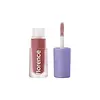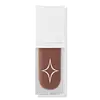Florence by Mills Be A VIP Velvet Liquid Lipstick Versus HALF MAGIC Mouth Cloud Soft Matte Lip Cream
What's inside
What's inside
 Key Ingredients
Key Ingredients

No key ingredients
 Benefits
Benefits

 Concerns
Concerns

No concerns
 Ingredients Side-by-side
Ingredients Side-by-side

Dimethicone
EmollientDimethicone/Vinyl Dimethicone Crosspolymer
Skin ConditioningIsododecane
EmollientDimethicone Crosspolymer
Emulsion StabilisingPolyglyceryl-2 Triisostearate
EmulsifyingMethyl Trimethicone
Skin ConditioningTrimethylsiloxysilicate
EmollientTridecyl Trimellitate
EmollientCetyl PEG/PPG-10/1 Dimethicone
EmulsifyingDisteardimonium Hectorite
StabilisingSorbitan Isostearate
EmulsifyingPhenoxyethanol
PreservativeDiisostearyl Malate
EmollientParfum
MaskingPropylene Carbonate
SolventAluminum Hydroxide
EmollientRosa Canina Fruit Oil
EmollientCI 77891
Cosmetic ColorantCI 45410
Cosmetic ColorantCI 77492
Cosmetic ColorantCI 77491
Cosmetic ColorantCI 77499
Cosmetic ColorantCI 42090
Cosmetic ColorantCI 19140
Cosmetic ColorantCI 15850
Cosmetic ColorantCI 15985
Cosmetic ColorantDimethicone, Dimethicone/Vinyl Dimethicone Crosspolymer, Isododecane, Dimethicone Crosspolymer, Polyglyceryl-2 Triisostearate, Methyl Trimethicone, Trimethylsiloxysilicate, Tridecyl Trimellitate, Cetyl PEG/PPG-10/1 Dimethicone, Disteardimonium Hectorite, Sorbitan Isostearate, Phenoxyethanol, Diisostearyl Malate, Parfum, Propylene Carbonate, Aluminum Hydroxide, Rosa Canina Fruit Oil, CI 77891, CI 45410, CI 77492, CI 77491, CI 77499, CI 42090, CI 19140, CI 15850, CI 15985
Dimethicone
EmollientMethyl Trimethicone
Skin ConditioningGlycerin
HumectantPolyisobutene
Diphenylsiloxy Phenyl Trimethicone
Skin ConditioningCetyl PEG/PPG-10/1 Dimethicone
EmulsifyingDiisostearyl Malate
EmollientTrimethylsiloxysilicate/Dimethiconol Crosspolymer
Butyl Acrylate/Hydroxypropyl Dimethicone Acrylate Copolymer
Boron Nitride
AbsorbentDiphenyl Dimethicone/Vinyl Diphenyl Dimethicone/Silsesquioxane Crosspolymer
Tricalcium Phosphate
AbrasiveDimethiconol
EmollientPhenoxyethanol
PreservativeAluminum Hydroxide
EmollientEthylhexylglycerin
Skin ConditioningSilica Dimethyl Silylate
EmollientTriethoxycaprylylsilane
CI 77891
Cosmetic ColorantCI 77491
Cosmetic ColorantCI 77492
Cosmetic ColorantCI 77499
Cosmetic ColorantCI 15850
Cosmetic ColorantDimethicone, Methyl Trimethicone, Glycerin, Polyisobutene, Diphenylsiloxy Phenyl Trimethicone, Cetyl PEG/PPG-10/1 Dimethicone, Diisostearyl Malate, Trimethylsiloxysilicate/Dimethiconol Crosspolymer, Butyl Acrylate/Hydroxypropyl Dimethicone Acrylate Copolymer, Boron Nitride, Diphenyl Dimethicone/Vinyl Diphenyl Dimethicone/Silsesquioxane Crosspolymer, Tricalcium Phosphate, Dimethiconol, Phenoxyethanol, Aluminum Hydroxide, Ethylhexylglycerin, Silica Dimethyl Silylate, Triethoxycaprylylsilane, CI 77891, CI 77491, CI 77492, CI 77499, CI 15850
Ingredients Explained
These ingredients are found in both products.
Ingredients higher up in an ingredient list are typically present in a larger amount.
Aluminum Hydroxide is a form of aluminum. It can be naturally found in nature as the mineral gibbsite. In cosmetics, Aluminum Hydroxide is used as a colorant, pH adjuster, and absorbent.
As a colorant, Aluminum Hydroxide may add opacity, or reduce the transparency. Aluminum hydroxide is contains both basic and acidic properties.
According to manufacturers, this ingredient is an emollient and humectant. This means it helps hydrate the skin.
In medicine, this ingredient is used to help relieve heartburn and help heal ulcers.
There is currently no credible scientific evidence linking aluminum hydroxide in cosmetics to increased cancer risk.
Major health organizations allow the use of aluminum hydroxide in personal care products and have not flagged it as a carcinogenic risk at typical usage levels.
Learn more about Aluminum HydroxideThis ingredient is a high molecular weight silicone. It has emulsifying and skin conditioning properties.
Ci 15850 is the pigment color red. It is an azo dye and created synthetically.
Azo dyes need to be thoroughly purified before use. This allows them to be more stable and longer-lasting.
This ingredient is common in foundations, lipsticks, and blushes. This color is described as brown/orangey red.
It has many secondary names such as Red 6 and Red 7. According to a manufacturer, Red 6 usually contains aluminum.
Learn more about CI 15850Ci 77491 is also hydrated iron III oxide. It's sole purpose is to give a red/pink hue to products.
Iron III oxides are classified as inorganic chemicals for coloring.
Synthetically created Ci 77491 is considered safer than those naturally found. This is because the synthetically created version may contain less impurities. Iron oxides are generally non-toxic and non-allergenic.
Learn more about CI 77491Ci 77492 is also hydrated iron III oxide. It's sole purpose is to give a yellow hue to products.
Iron III oxides are classified as inorganic chemicals for coloring.
Synthetically created Ci 77492 is considered safer than those naturally found. This is because the synthetically created version may contain less impurities. Iron oxides are generally non-toxic and non-allergenic.
Learn more about CI 77492Ci 77499 is also hydrated iron III oxide. It is created from mixing red and black iron oxides. This helps give shades of darkness to a product.
Iron III oxides are classified as inorganic chemicals for coloring.
Ci 77891 is a white pigment from Titanium dioxide. It is naturally found in minerals such as rutile and ilmenite.
It's main function is to add a white color to cosmetics. It can also be mixed with other colors to create different shades.
Ci 77891 is commonly found in sunscreens due to its ability to block UV rays.
Learn more about CI 77891Diisostearyl Malate is an emollient and most often used in lip products. It comes from isostearyl alcohol, a fatty acid, and malic acid, an AHA.
As an emollient, Diisostearyl Malate helps create a thin film on your skin to trap moisture in. This helps keep your skin soft and smooth.
Dimethicone is a type of synthetic silicone created from natural materials such as quartz.
What it does:
Dimethicone comes in different viscosities:
Depending on the viscosity, dimethicone has different properties.
Ingredients lists don't always show which type is used, so we recommend reaching out to the brand if you have questions about the viscosity.
This ingredient is unlikely to cause irritation because it does not get absorbed into skin. However, people with silicone allergies should be careful about using this ingredient.
Note: Dimethicone may contribute to pilling. This is because it is not oil or water soluble, so pilling may occur when layered with products. When mixed with heavy oils in a formula, the outcome is also quite greasy.
Learn more about DimethiconeMethyl Trimethicone is a type of silicone. It is a solvent and emulsifier.
Solvents are used to keep ingredients together in a product. They can help dissolve ingredients to stable bases or help evenly distribute ingredients throughout the product.
Emulsifiers help stabilize a product. It does this by preventing certain ingredients from separating.
Methyl Trimethicone does not get absorbed into the skin.
Learn more about Methyl TrimethiconePhenoxyethanol is a preservative that has germicide, antimicrobial, and aromatic properties. Studies show that phenoxyethanol can prevent microbial growth. By itself, it has a scent that is similar to that of a rose.
It's often used in formulations along with Caprylyl Glycol to preserve the shelf life of products.